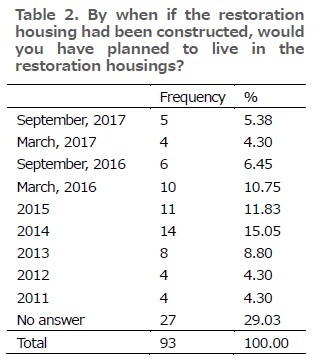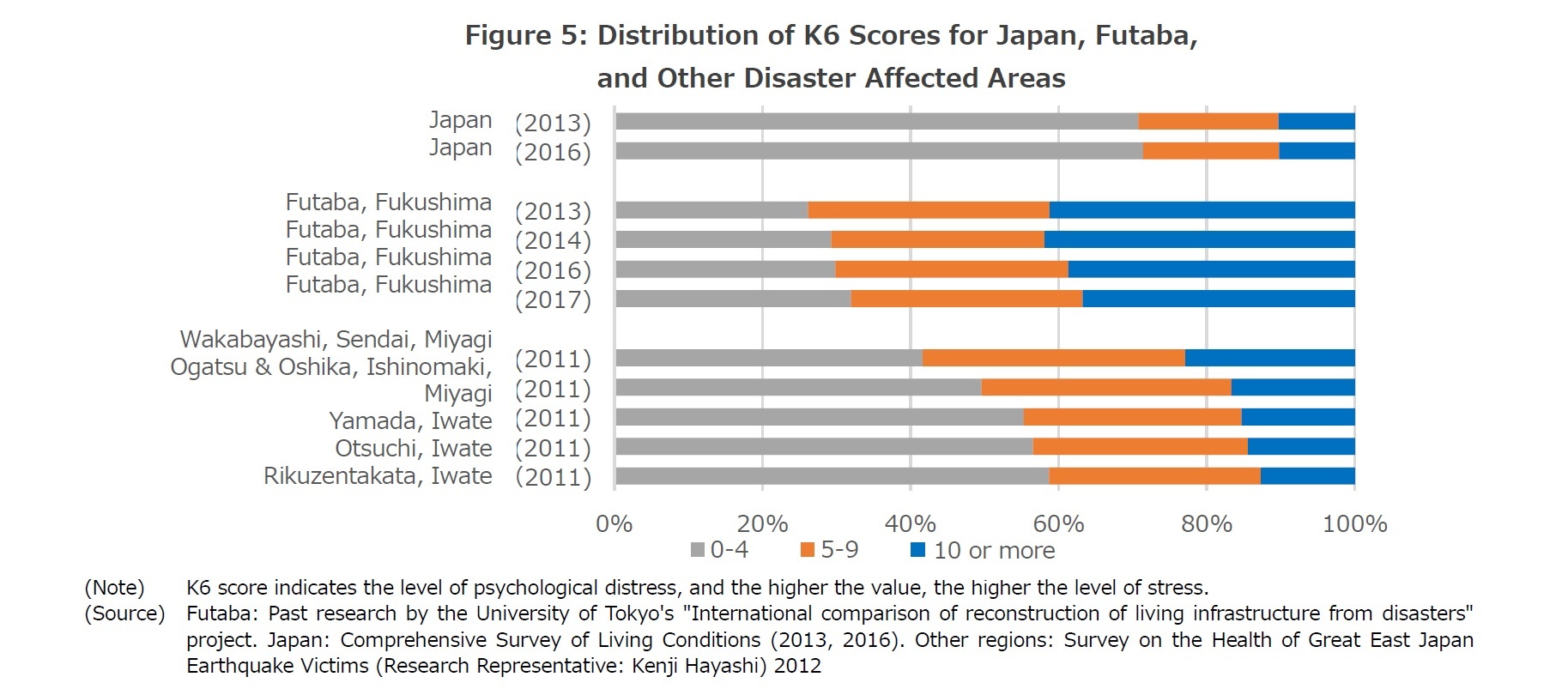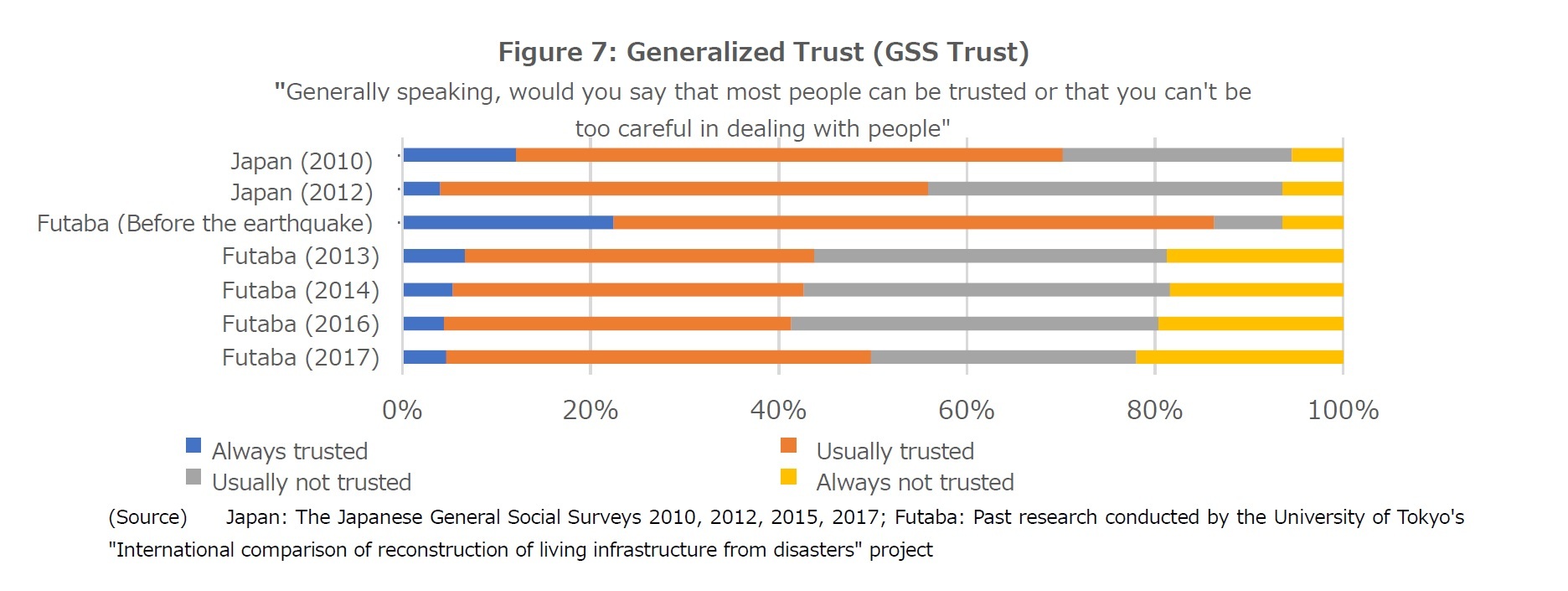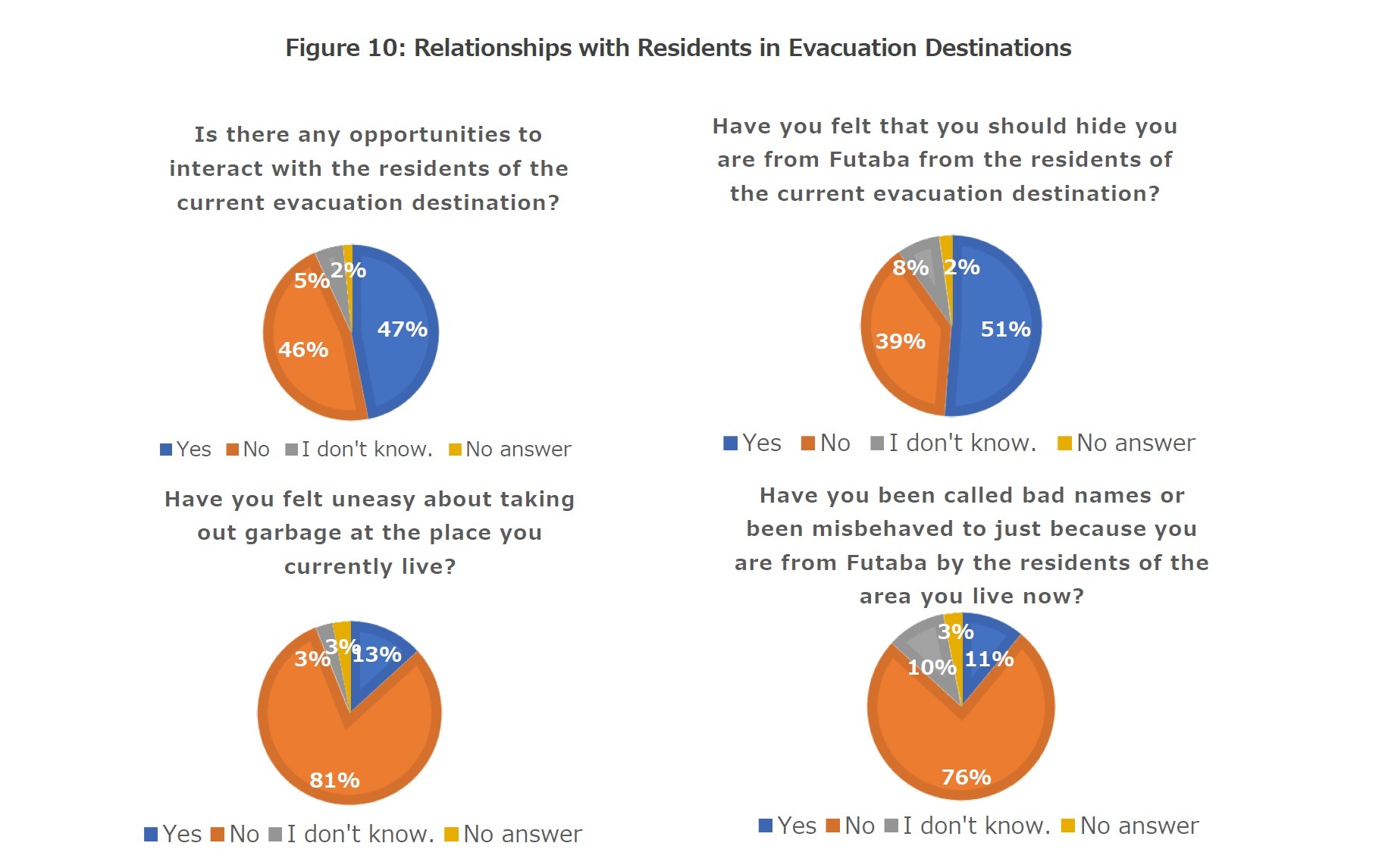- シンクタンクならニッセイ基礎研究所 >
- 暮らし >
- ライフデザイン >
- Damage, Living Environment, and Reconstruction Under the Great East Japan Earthquake-The 4th Survey of Nuclear Disaster Evacuees from Futaba, Fukushima, Summary of Results 2017
Damage, Living Environment, and Reconstruction Under the Great East Japan Earthquake-The 4th Survey of Nuclear Disaster Evacuees from Futaba, Fukushima, Summary of Results 2017

保険研究部 准主任研究員 岩﨑 敬子
このレポートの関連カテゴリ
文字サイズ
- 小
- 中
- 大
1――Basic Information
The survey targeted heads of households and Figures 1 and 2 show the distribution of age and gender of the respondents. As we can see from these figures, compared to the age and gender distribution reported in the national census, the age distribution of the respondents is left-skewed, with the majority of respondents in their 60s. The gender distribution shows that the majority of respondents are male. In addition, since the survey was conducted after the tremendous disaster, it is possible that the distributions of the respondents' characteristics are significantly different from those of general questionnaire surveys. Therefore, it should be noted that the results of this survey do not necessarily indicate the general trend of Futaba residents.
1 This research was supported by the following research grants.
Grant-in-Aid for Scientific Research (15 J09313, 26220502, LZ003), Research Grants of the Japan Center for Economic Research.
This study is approved by the Ethics Committee of the University of Tokyo (19 -73).
2――Health Condition
3――Change in Social Capital
There are several indicators that are commonly used to measure social capital, but we focused on three items. First, we checked the level of "generalized trust" using the GSS trust question, which is one of the most commonly used social capital measures. Generalized trust among Futaba residents had been decreasing from 2013 to 2016 (portion of those that think people can be trusted had been decreasing). However, in 2017, the portion of those that think people can be trusted has increased and the overall distribution can be considered to have shifted to the recovery trend (see Figure 7). On the other hand, the portion of those that think we should be always careful in dealing with people has been increasing and we need a continuous careful observation. In addition, the second indicator of social capital, "frequency of mutual assistance with neighbors" and the third indicator, "trust of neighbors" hardly shows recovery trend. It will take a very long time for social capital to recover, and we believe it is important to continue to monitor these changes over the long term.
4――Building Relationships with Residents at Evacuation Destinations
5――Nakoso-Sakai Public Restoration Housing
 As a hub complex housing for Futaba residents outside of the town of Futaba, Nakoso-Sakai public restoration housing is under construction. Since we received some opinions about the construction timing of the restoration housing from some of Futaba residents, we included questions asking if the residents know about this Nakoso-sakai public restoration housing and by when if the restoration housing had been constructed, they have planned to live in the restoration housings. As to the first question, about 60% of the residents answered that they know about the Nakoso-Sakai public restoration housing under construction. Also, 12% of the respondents (93 people) answered that they would have planned to live in the restoration housing if it had been built earlier. The distribution of the answer to the second question is shown in Table 2.
As a hub complex housing for Futaba residents outside of the town of Futaba, Nakoso-Sakai public restoration housing is under construction. Since we received some opinions about the construction timing of the restoration housing from some of Futaba residents, we included questions asking if the residents know about this Nakoso-sakai public restoration housing and by when if the restoration housing had been constructed, they have planned to live in the restoration housings. As to the first question, about 60% of the residents answered that they know about the Nakoso-Sakai public restoration housing under construction. Also, 12% of the respondents (93 people) answered that they would have planned to live in the restoration housing if it had been built earlier. The distribution of the answer to the second question is shown in Table 2.
6――Summary of Findings from the Four Rounds of Surveys
(2) In particular, there was a possibility that the mental health of those who had lived in temporary shelters for a long time was in a serious condition.
(3) As to changes in income, health status, and living space caused by the disaster, we find that the greater the extent of decrease or deterioration is, the greater the degree of decline in individual well-being tends to be.
(4) The disaster has weakened the social capital of Futaba residents, and recovery may take a very long time.
(5) Keeping in touch with friends from pre-disaster times as well as participating in hobbies and volunteer activities after the disaster may help people maintain good mental health.
(6) The receptive attitudes of residents in the evacuation destinations and successful relationship buildings between the evacuees and residents in evacuation destinations can help to achieve mental health recovery of the evacuees.
These results have been presented at international and domestic academic conferences. In addition, these results have been published in international academic journals. We intend to continue our analysis and contribute to the improvement of disaster preparation/rehabilitation policies.
Our survey results are based on aggregates and analyses of responses from approximately 26% of the households of Futaba and do not represent all Futaba residents. Since the survey was conducted after a major disaster, the characteristics of respondents may be very different from general surveys and there is a possibility of an overestimation in our results due to the deterioration of physical and mental health conditions. Therefore, special caution is required in interpreting the results, and any definitive judgments based solely on these findings should be avoided.
(2020年03月17日「基礎研レポート」)
このレポートの関連カテゴリ
関連レポート
- Damage, Living Environment, and Reconstruction Under the Great East Japan Earthquake-The 5th Survey of Nuclear Disaster Evacuees from Futaba, Fukushima, Summary of Results 2019
- 「東日本大震災による被害・生活環境・復興に関するアンケート」2017年調査結果概要-福島県双葉町民を対象とした第4回調査
- 「東日本大震災による被害・生活環境・復興に関するアンケート」2019年調査結果概要-福島県双葉町民を対象とした第5回調査
- 「東日本大震災による被害・生活環境・復興に関するアンケート」2016年調査結果概要-福島県双葉町民を対象とした第3回調査
- 「東日本大震災による被害・生活環境・復興に関するアンケート」2014年調査結果概要-福島県双葉町民を対象とした第2回調査
- 「東日本大震災による被害・情報取得経路・復興に関するアンケート」2013年調査結果概要-福島県双葉町民を対象とした第1回調査

03-3512-1882
- 【職歴】
2010年 株式会社 三井住友銀行
2015年 独立行政法人日本学術振興会 特別研究員
2018年 ニッセイ基礎研究所 研究員
2021年7月より現職
【加入団体等】
日本経済学会、行動経済学会、人間の安全保障学会
博士(国際貢献、東京大学)
2022年 東北学院大学非常勤講師
2020年 茨城大学非常勤講師
岩﨑 敬子のレポート
| 日付 | タイトル | 執筆者 | 媒体 |
|---|---|---|---|
| 2025/06/30 | マスク着用の子どもへの影響-コロナ禍の研究を経て分かっていること/いないこと | 岩﨑 敬子 | 基礎研レポート |
| 2025/06/26 | マスク着用のコミュニケーションへの影響(2)-コロナ禍の研究を経て分かっていること/いないこと | 岩﨑 敬子 | 基礎研レター |
| 2025/06/23 | マスク着用のコミュニケーションへの影響(1)-コロナ禍の研究を経て分かっていること/いないこと | 岩﨑 敬子 | 基礎研レター |
| 2025/06/19 | マスク着用のメンタルヘルスへの影響(2)-コロナ禍の研究を経て分かっていること/いないこと | 岩﨑 敬子 | 基礎研レター |
新着記事
-
2025年10月21日
選択と責任──消費社会の二重構造(2)-欲望について考える(3) -
2025年10月21日
連立協議から選挙のあり方を思う-選挙と同時に大規模な公的世論調査の実施を -
2025年10月21日
インバウンド消費の動向(2025年7-9月期)-量から質へ、消費構造の転換期 -
2025年10月21日
中国、社会保険料徴収をとりまく課題【アジア・新興国】中国保険市場の最新動向(71) -
2025年10月21日
今週のレポート・コラムまとめ【10/14-10/20発行分】
レポート紹介
-
研究領域
-
経済
-
金融・為替
-
資産運用・資産形成
-
年金
-
社会保障制度
-
保険
-
不動産
-
経営・ビジネス
-
暮らし
-
ジェロントロジー(高齢社会総合研究)
-
医療・介護・健康・ヘルスケア
-
政策提言
-
-
注目テーマ・キーワード
-
統計・指標・重要イベント
-
媒体
- アクセスランキング
お知らせ
-
2025年07月01日
News Release
-
2025年06月06日
News Release
-
2025年04月02日
News Release
【Damage, Living Environment, and Reconstruction Under the Great East Japan Earthquake-The 4th Survey of Nuclear Disaster Evacuees from Futaba, Fukushima, Summary of Results 2017】【シンクタンク】ニッセイ基礎研究所は、保険・年金・社会保障、経済・金融・不動産、暮らし・高齢社会、経営・ビジネスなどの各専門領域の研究員を抱え、様々な情報提供を行っています。
Damage, Living Environment, and Reconstruction Under the Great East Japan Earthquake-The 4th Survey of Nuclear Disaster Evacuees from Futaba, Fukushima, Summary of Results 2017のレポート Topへ


























 各種レポート配信をメールでお知らせ。読み逃しを防ぎます!
各種レポート配信をメールでお知らせ。読み逃しを防ぎます!




